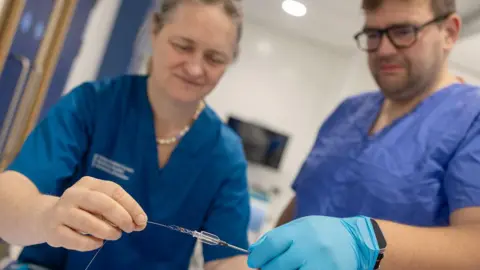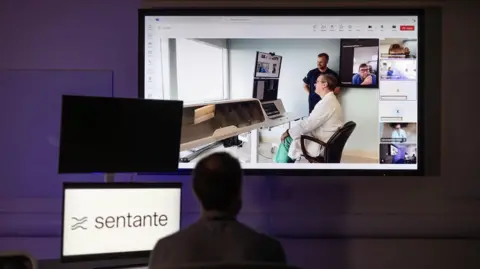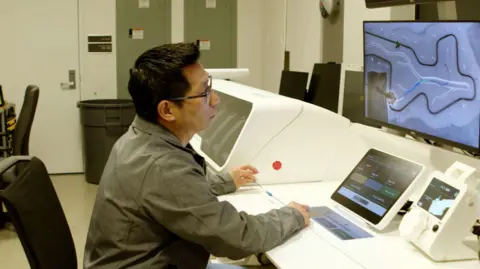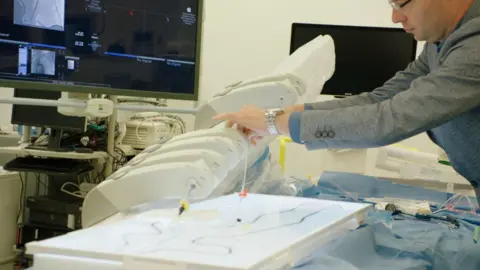Graham FressBBC Scotland
 University of Dundee
University of DundeeDoctors from Scotland and the US have completed what is thought to be the first procedure in the world using a robot.
Prof Iris Grunwald, of the University of Dundee, performed remote thrombectomy – the removal of blood clots after a stroke donated to medical science.
The professor at Nanquells Hospital in Dundee, while the body he ran while using the machine across the university town.
Hours later, Ricardo Hanel – a neurosurgeon in Florida – used the technology to fulfill his body in JackSonville in Dundee in Dundee (6,400km away).
 University of Dundee
University of DundeeThe team calls it a potential “Game Coser” if it is approved for use in patients.
Doctors believe that this technology can revolutionize stroke care, as a delay in access to specialist treatment can have a direct impact on the chances of recovery.
Prof Prof Gallwald said: “It is as if we are witnessing the first glimpse of the future.
“Where it’s thought to be science fiction, we’ve shown that every step of the way can be done.”
The University of Dundee is the Global Training Center of the World Federation for interventional stroke treatment with departments that have blood vessels in the treatment of a living person in a living person.
“This is the first time we can perform the entire thrombectomy procedure in a real human body to show that all the steps of the procedure are possible,” said Prof pro Grunwald.
Juliet Bouverie, the Chief Executive of the Stroke Association Charity, told BBC News that the transatlantic approach was “an incredible change”.
He added: “For too long, people living in remote and mountainous areas have been deprived of access to thrombectomy.
“Robotics like this can restore reliability to stroke care across the UK.”
 University of Dundee
University of DundeeIn the experiment, human blood was used in four different cadavers. Bodies are donated to science, with subjects who have died in the past three years and then embalmed.
Both Dundee and Florida procedures were carried out last month using robotics from Lithuanian Firm Fird Sendante.
While there are isolated thrombectomies carried out before Silicon modela 3D printed replica and of an animalit is thought to be the first method of a human body.
The team now hopes to participate in clinical trials next year.
How does the technology work?
An ischemic stroke occurred When an artery is blocked by a shoe.
This cuts off the blood and oxygen supply to the brain, and brain cells lose function and die.
The best treatment is a thrombectomy, where a specialist uses catheters and wires to remove the clot.
But what happens if a patient cannot reach a specialist who can perform the procedure?
Prof Grunwald explained that the experiment shows a robot that can be connected to the same cathers and wires that a surgeon usually uses, and a medicine that accompanies the patient can only connect the wires.
The surgeon, in another location, can hold and move their own wires, and the robot then carries out the same movements in real time to the patient to perform the thrombectomy.
The patient will be in a hospital operating room, while the doctor can perform the procedure using the Sendante Machine from anywhere – even in their own home.
Prof Grunwald and Ricardo Hanel saw the Live X-Rays of the Body in the experiments, and monitoring the progress in real time, which the Dundee expert said was about 20 minutes of training.
Tech giants NIVVIA and ERICSSON are involved in the project to ensure robot connectivity.
Dr Handel said: “To move from the US to Scotland with a 120 millisecond lag – a blink of an eye – is truly extraordinary.”
 Sender
Sender Sender
SenderThe future of stroke treatment
Prof Grunwald, who won an award from the UK for his work and is also the vice president of FEDROCTERO – there is a global shortage of doctors who can do it, and the treatment depends on your location.
In Scotland, there are only three areas where patients can receive the procedure – Dundee, Glasgow and Edinburgh. If you don’t live there, you have to travel.
Prof Priernald said: “The treatment is time sensitive.
“For every six minutes of delay, there is a 1% less chance of a good outcome.
“This technology will now provide a new way where you do not depend on where you live – saving precious minutes where your brain does not die.”
Public Health Scotland says There were 9,625 ischemic strokes in Scotland last year.
Only 212 – or 2.2% of all patients – received a thrombectomy, while 1,045 people received medication to break the clots.
For the rest of the UK, Only 3.9% of all stroke patients received a thrombectomy in the year to March 2024.
“It felt strange,” added Edvardas Satkauskas, Sendante’s CEO, speaking to BBC News from the company’s base in Lithuania.
“Sometimes, the future is much closer than we think.”


